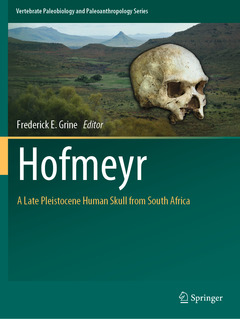Description
Hofmeyr, 1st ed. 2022
A Late Pleistocene Human Skull from South Africa
Vertebrate Paleobiology and Paleoanthropology Series
Coordinator: Grine Frederick E.
Language: English
Subjects for Hofmeyr:
Publication date: 12-2023
258 p. · 21x27.9 cm · Paperback
Publication date: 12-2022
258 p. · 21x27.9 cm · Hardback
Description
/li>Contents
/li>Biography
/li>Comment
/li>
Dr. Frederick Grine’s research focuses on the fossil record for human evolution, with particular emphasis on the African evidence. He is particularly interested in the reconstruction of past diets and behaviors, and in the evolutionary (phylogenetic) relationships among the different hominid species. He conducted archaeological excavations at the Middle Stone Age site of Die Kelders, South Africa, and has expertise with the Late Pleistocene record for the emergence of modern humans.




